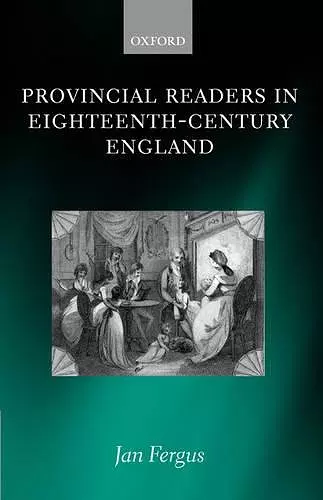Provincial Readers in Eighteenth-Century England
Format:Hardback
Publisher:Oxford University Press
Published:25th Jan '07
Currently unavailable, and unfortunately no date known when it will be back

Many scholars have written about eighteenth-century English novels, but no one really knows who read them. This study provides historical data on the provincial reading publics for various forms of fiction - novels, plays, chapbooks, children's books, and magazines. Archival records of Midland booksellers based in five market towns and selling printed matter to over thirty-three hundred customers between 1744 and 1807 form the basis for new information about who actually bought and borrowed different kinds of fiction in eighteenth-century provincial England. This book thus offers the first solid demographic information about actual readership in eighteenth-century provincial England, not only about the class, profession, age, and sex of readers but also about the market of available fiction from which they made their choices - and some speculation about why they made the choices they did. Contrary to received ideas, men in the provinces were the principal customers for eighteenth-century novels, including those written by women. Provincial customers preferred to buy rather than borrow fiction, and women preferred plays and novels written by women - women's works would have done better had women been the principal consumers. That is, demand for fiction (written by both men and women) was about equal for the first five years, but afterward the demand for women's works declined. Both men and women preferred novels with identifiable authors to anonymous ones, however, and both boys and men were able to cross gender lines in their reading. Goody Two-Shoes was one of the more popular children's books among Rugby schoolboys, and men read the Lady's Magazine. These and other findings will alter the way scholars look at the fiction of the period, the questions asked, and the histories told of it.
fascinating study of provincial bookbuyers and book borrowers in the Midlands in the second half of the eighteenth century. * Claire Brant MLR *
a valuable piece of scholarship, and must become an essential point of departure for any discussion of the history of reading practices and provincial culture in the eighteenth century. * Rosemary Sweet Literature and History *
makes a helpful contribution to the history of reading...we can be grateful to Jan Fergus for giving us this thought-provoking foray into the Midland archives. * Richard B. Sher, The Review of English Studies *
Rare is a book that uses a slender and apparently particularized archive to transform broader historical understanding. Such a volume is Jan Fergus's investigation of the audience for fiction in eighteenth-century England... skilfully written. Rarely has understatement been so effective, and admonitions are delivered with devastating politeness. * James Raven, TLS *
...impressive...I enjoyed this book greatly * William Noblett, Rare Books Newsletter, No. 81 *
The immense scholarly labour Fergus puts in...[helps] to make some very challenging and important claims about the book trade and reading practices...incredibly revealing of the patterns of reading...a very important book * The Cambridge Quarterly, Volume 26, Number 4 *
Fergus offers a vivid depiction of reading as a scene of cultural desire and prohibition * ECF *
represents an undeniably valuable contribution to the new interdisciplinary field of book history ... far from being a dry study of numbers, sets out a provocative snap-shot of the material reality for a reading public forming in early modern England. * Kirk Combe, Notes and Queries *
ISBN: 9780199297825
Dimensions: 240mm x 160mm x 20mm
Weight: 523g
336 pages